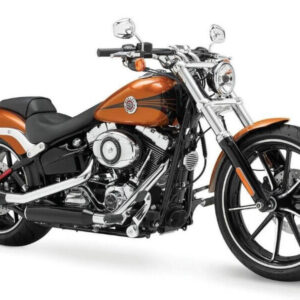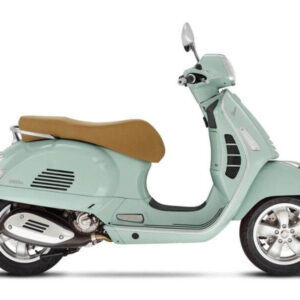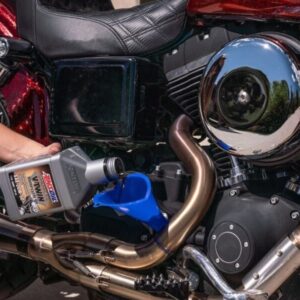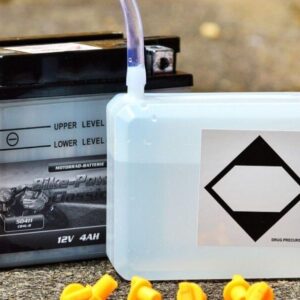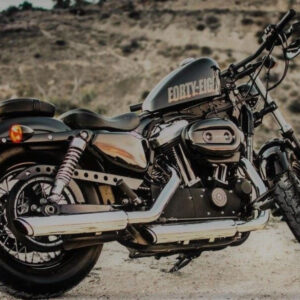Where is the VIN number on a motorcycle? Vehicle Identification Number (VIN), is known as the chassis number. You need to be able to locate the VIN to know what the chassis number is.
There’s a slight possibility that you will need to check a few spots on the bike for this number, as it can be located in different places.
Where is The VIN Number on a Motorcycle?
Generally speaking, with the vast majority of motorcycles, the VIN is found to the right of the headstock tube. Usually on the part of the frame that the forks go through, underneath the throttle. The VIN will be stamped deep into the frame.

Just as people have National Identification or Social Security numbers, vehicles of all kinds are assigned unique, coded numbers called Vehicle Identification Numbers. They are crucial if you are trying to track down the parts you need to rebuild or repair a car, truck, motorcycle, or even a boat (although watercraft owners refer them as “hull identification numbers, or HINs).
VINs are used to track the ownership and repair history of a vehicle, process insurance claims, and maintain state registration records.
You can use a vehicle’s identification number to learn whether it has been wrecked or stolen, whether it has had major recalls, and whether it hail or flooding have caused damage. Additionally, you can check any vehicle’s service and registration histories, see when it was last inspected, see how many previous owners it has had, and find out if someone previously reported odometer fraud.
Whether you’re looking at Ducati prices or the cost of a simple Yamaha, these are important factors to consider. A bike that was once damaged should be priced accordingly, and you’ll want to have it thoroughly inspected by a licensed, trusted mechanic to ensure that it functions correctly and safely.
Similarly, a motorcycle’s ownership and service records can paint a pretty clear picture of how well its previous owners cared for it and whether it’s worth the asking price.
A bike that has changed hands many times or have undergone numerous repairs times might have performance problems that make people want to get rid of it, and if a bike hasn’t had regular maintenance, its lifespan and reliability may suffer.
Further, if the motorcycle you’re looking at has been reported stolen, the legitimate owner might have settled with their insurance company, and you may be facing extra fees to obtain a clear title – at best. At worst, the previous owner might demand the return of their property, in which case you’ll likely lose whatever money you spent on it.
All About the VIN
US Auto manufacturers started using vehicle identification numbers in 1954, but there wasn’t an agreed-upon standard for their format, so each manufacturer had its own approach.
In the United States, the National Highway Traffic Safety Commission began requiring the use of VINs for on-road vehicles – everything from cars to ATVs – in 1981. You’ll typically find the VIN plate somewhere on the frame, often on the steering column.
Most modern bikes have a VIN on both the engine and the frame, and if they don’t match, it’s a clear indication that the vehicle has been rebuilt or modified and might be a red flag for theft.
If you’re dealing with a classic motorcycle or a bike that was manufactured outside the US, finding the VIN tag can be a bit more challenging. Most of the time, it will still be somewhere on the frame or the engine case, but you may need to poke around a bit to find it.

Check the steering neck, behind the headlight, and on the front frame rail, and try using Google Images to find photos that show the VIN’s location on a similar make and model.
Whether it’s associated with a motorcycle, dirt bike, ATV, or car, each VIN is 17 characters long, and alpha-numeric, which means that they use the numbers 0 through 9 and the letters A through Z.
However, VINs never use the letters I, O, and Q – it’s too easy to confuse the letter I with the number 1, and O or Q with a zero. They also omit other special characters like pound signs and ampersands, all punctuation marks, and spaces.
European manufacturers use a similar, although less stringent system. VINs in the EU don’t include the year of manufacture or the vehicle’s technical attributes, but they still generally compatible with the North American system. In fact, most countries use some form of identification schema that is more or less comparable.
Decoding a VIN Number
Every VIN can be broken down and interpreted, or “decoded.” To do so, you’ll need to track down lists of country, manufacturer, and factory codes, and painstakingly cross-reference these with the values in each of the positions of your VIN. Alternately, you can avail yourself of the magic that is the internet, and use any of the numerous free online VIN decoders.
Just type the number into a box and click the button, and the decoder will query a commercial vehicle dataset and return details about your machine.
However, you should be aware that datasets vary – if the online VIN decoder you happen to choose references a dataset that’s not very comprehensive, you may not get much (or even any) information back. Not to worry though: you can always try another.
That said, and even though the internet has all the answers these days, it’s still cool to understand what the different digits in a VIN represent, and how much information its designers were able to cram in 17 places!
To get to know your VIN, start by breaking it into three sections: the first three digits, followed by the next six digits, and then the last eight digits.
The first section of the VIN represents the World Manufacturer Identifier, which tells you the vehicle’s country of origin. Manufacturers based in the United States use either the number 1 or the number 4 in the first position; Canadian companies use 2, but some European companies use letters. For example, German bike numbers begin with W, and English models begin with S.
The second digit represents the name of the manufacturer, and the third digit is used to indicate the type of vehicle. Most motorcycles VINs have either a 1 or an A in the third spot.
The six digits in the second section indicate technical specifications such as engine size and type, model, and brand. These are followed by eight characters which provide additional details about the motorcycle’s manufacturer.
The 10th digit indicates the year in which the bike was built, and since depreciation sharply affects the prices of motorcycles, especially during the first two years after manufacture, this is an important bit of information. The value in the 11th spot is a factory code – not so important as the manufacture date, but still interesting. Characters 12 through 17 are a serial number.
Your VIN is a Valuable Resource
Whether or not you decode your VIN, it’s the key to a wealth of information that you can use to estimate used motorcycle values, negotiate with potential sellers, and arrive at a fair purchase price for your next 2-wheeled machine.
Once you know the exact make, model, and year of the motorcycle you’re thinking of buying, you can research what it should cost, factoring in its condition, the region you’re in, and whether or not the bike has any custom features or high-end options.
Further, as mentioned above, you can also use a motorcycle’s VIN to make sure it hasn’t been stolen, wrecked, or recalled for safety problems. There are several commercial services that charge a nominal fee to run your VIN through the government’s Motor Vehicles Division database and deliver a comprehensive report.

When a motorcycle or other vehicle is reported stolen, the police flag its VIN in the MVD database; after that, any check on the VIN will reveal the theft and let potential buyers know that no one can legitimately re-sell the vehicle.
Additionally, be sure to inspect the VIN tag for signs that it might have been ground down and re-stamped with a different number, as this is a technique thieves often use. And as always, if the price seems too good to be true, it probably is, so trust your instincts and caveat emptor.
What’s The Purpose of The VIN?
Essentially the Vehicle Identification Number serves as a fingerprint for the vehicle, as no two vehicles will have the same number. In terms of your motorcycle, the unique 17 character number, which is made up of digits and capital letters, allows you to accurately check its age.
The VIN also displays the bike’s unique features, specifications and manufacturer, and can also be used to track recalls, registrations, warranty claims, thefts and insurance coverage.
The Importance of The VIN
Unfortunately, there are motorcycle sellers out there who will claim that the bike they are selling is much newer than it actually is. Checking the VIN can be hugely important for determining the true age of the bike you’re buying. Plus, the VIN is also the safest way of establishing the true identity of the motorcycle, and verifying whether the used bike is suspect or not.
Vehicle manufacturers and registration agencies carry databases of Vehicle Identification Numbers, so that they can accurately identify and validate a particular vehicle, simply by entering the number. If you find yourself buying a second hand motorcycle, you can use of the many companies who offer VIN number checking services.
If any irregularities come up when checking the number, you can instantly know that there’s something not right with the vehicle. When you don’t have access, for whatever reason, to your motorcycle, or to one you’re thinking of buying; you can check the paperwork for the VIN.
FAQs
How many VIN numbers does a motorcycle have?
As mentioned earlier, VINs produced to be used or sold in the US will have 17 characters including letters and numbers. No motorcycle VIN will have the letters O, Q, and I to avoid their similar-looking numerical counterparts.
What should a motorcycle VIN look like?
A typical motorcycle Vehicle Identification Number (VIN) consists of 17 characters, which can be divided into three main sections: World Manufacturer Identifier (WMI): the first three characters of the VIN represent the WMI, which identifies the motorcycle’s manufacturer and the country or region where it was produced.
Is engine number and VIN the same on a motorcycle?
No, the engine number is not the same as the motorcycle VIN. The VIN (Vehicle Identification Number) is the 17-digit code stamped in a few different locations on the bike. The VIN is the number that is primarily used for title and registration, motorcycle insurance, and other record keeping.
Above is information about Where is the VIN number on a motorcycle? that we have compiled. Hopefully, through the above content, you have a more detailed understanding of What’s the purpose of the VIN? Thank you for reading our post.

